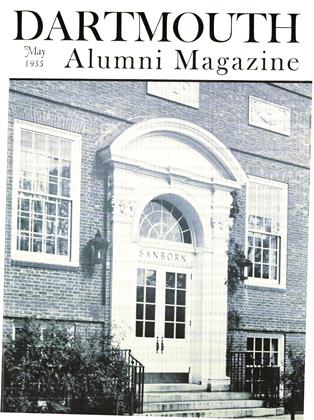Fire of unknown origin gutted Dartmouth Hall in the early morning hours of April 25, causing damage unofficially estimated at $75,000 and wiping out the invaluable work of several faculty members. Five small fires discovered in other college buildings while Dartmouth Hall was in flames gave rise to the suspicion of arson, but an investigation by the, College disclosed no connection between the big blaze and the smaller ones, which were extinguished promptly and appeared to be the handiwork of some student with a perverted sense of humor.
The Dartmouth Hall fire, reminiscent of the one which completely destroyed the historic structure in 19,04, started in the north wing of the building and was well under way before discovered by a student at 1:20 in the morning. Seemingly localized at first, the blaze assumed serious proportions with the discovery that it was climbing rapidly through inaccessible shafts to the upper floors and the roof, which eventually caught fire. Volunteer firemen from Hanover and Lebanon battled the flames for five hours before getting them under control, and by that time the interior of the building had been largely gutted. The tower of Dartmouth Hall toppled at 5:30, and when surprised students arose for Thursday morning classes, the building was still smoldering. Many students were aroused by the fire whistles, but the catastrophe was a complete surprise to the larger portion of the student body. The Undergraduate Fire Squad, headed by Donald C. Hagerman '35, of Arlington, Mass., took an active part in fighting the fire and controlling student spectators.
The five smaller fires which gave rise to the theory of a firebug were discovered in Middle Fayerweather, Wentworth, Richardson, McNutt and the south wing of Dartmouth Hall. The first two were discovered in fireproof phone booths, minimizing the suspicion of an incendiary. In McNutt and the south wing of Dartmouth Hall similar blazes were found in desks, and in the fifth case Hunt Sutherland '36, of New Bedford, Mass., awoke in his room on the ground floor of Richardson to find an unknown person hurrying from his room and a paper bag ablaze on his desk.
The damage to Dartmouth Hall is substantially covered by insurance, although it is expected that the College will incur considerable additional expense in remodelling the interior of the building. Reconstruction will begin at once, with modern fireproofing added throughout the structure.
With the exception of the Fayerweather fire in 1910, the College has had a remarkable record of fire prevention since the earlier destruction of Dartmouth Hall. An all-night patrol by College watchmen is always maintained, and for the immediate future this will be enlarged.
 View Full Issue
View Full Issue
More From This Issue
-
 Article
ArticleHANOVER BROWSING
May 1935 By Herbert F. West '22 -
 Article
ArticleHANOVER SUBMERGED
May 1935 By Richard J. Lougee '27 -
 Class Notes
Class NotesClass of 1918
May 1935 By Allan C. Gottschaldt -
 Class Notes
Class NotesClass of 1930
May 1935 By Albert I. Dickerson -
 Class Notes
Class NotesClass of 1904
May 1935 By David S. Austin, II -
 Class Notes
Class NotesClass of 1905
May 1935 By Arthur E. McClary







